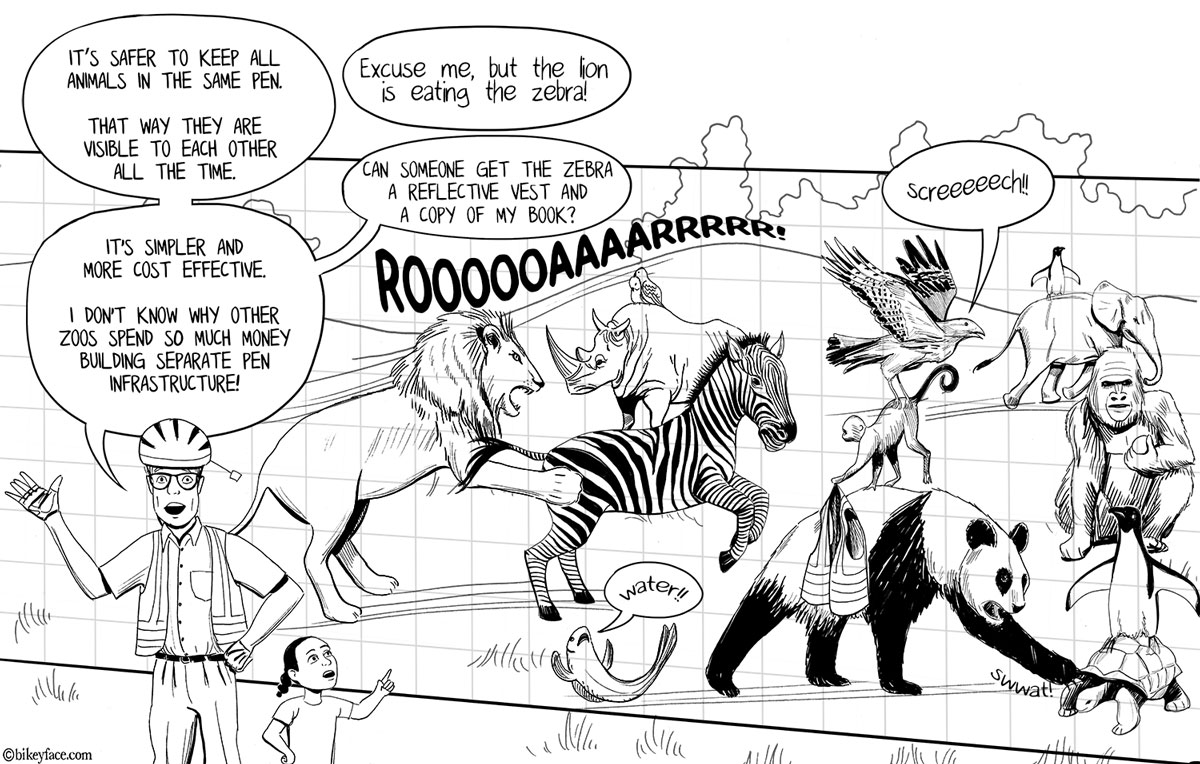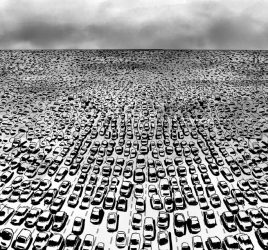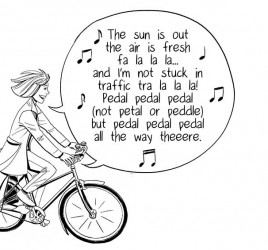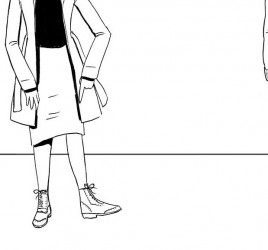
A Zoo
I have to bicycle vehicularly most of the time because there’s not much infrastructure yet. But I’d prefer not to. What I can’t understand why anyone would argue against protected bike lanes.
I wonder how the argument would go if applied to other things- like a zoo?





For one thing, we are not all zoo animals, we are people. We are not predators, nor prey. We are cooperative members of the traffic system.
For another, so-called “protected bike infrastructure” is even worse where the crashes happen–in and around intersections. Oddly, so-called studies that claim that “protected bike infrastructure” is safer seem to ignore the crashes that happen in and around intersections when counting the different crash rates. “Oh, those crashes happen in the road, not in the protected bike way,” is disingenuous when it’s the intersection geometry resulting from the protected bike way that is the problem.
Get rid of the “protected bike way,” treat cyclists as drivers of vehicles instead of as wheeled pedestrians, and watch the crash rate drop.
As for the noises other road users make around me when I’m on my bicycle, I note that those same road users bark at other motorists, too, when those other motorists aren’t going fifty in a thirty-five zone, or are otherwise driving with care for the rest of the road users instead of as if they are vying for the next World Rally Cup title. I don’t take their barking seriously. I’m not the reason for their emotional state.
Did you wake up right now from some hibernation from 1990?
We’ve had ‘separated infrastructure’ for decades for pedestrians. It’s called a sidewalk. And guess where almost all of the pedestrian crashes/jnjuries occur? When someone tries to cross the street and steps from the sidewalk to the roadway. So, by your logic, we should get rid of sidewalks and throw all of the pedestrians into the street so they can practice ‘vehicular walking’.
Wow, Tom, you sure do sound like a relic from another era. VC’ers can make all the noise they want about how VC’ing is supposedly safer than protected bike paths, but one thing that they never mention is the success rate of VC’ing: just how many people actually bike like a vehicle? I do, out of necessity, but I would rather be safe from cars and have a network of separated cycle paths. Compare that number to the number of people who use good cycle paths, both in the US and in more-developed nations: you’ll find that the cycling rate is much higher, particularly among non-MAMILs. All of the safety lectures, books, and high-visibility clothing in the world won’t hep you in a collision with a motor vehicle. The physics are undeniable: greater mass * greater speed = exponentially greater force in an impact. Many people grasp that concept and are justifiably scared to ride in the streets. Only separated bike paths will increase the number of bicyclists out there.
The reason why cycling provision in the Netherlands and Denmark is about four decades ahead of that in the UK and the United States, and that in Germany and France three decades, is that in none of those countries was debate about cycling infrastructure distracted as it was in the English-speaking world by the crackpot sympathetic-magic theories of the Prophet Forester and his disciples, which were highly attractive to central and local government because they essentially involved their doing nothing. In continental Europe it’s taken as axiomatic by traffic planners that bicycles, though road vehicles of a kind, are not equivalent to motor vehicles in the same way that gliders, though undeniably aircraft, don’t behave the same way as powered aircraft and need special protection. The infrastructure provided may not be perfect – even Dutch road engineers get it wrong sometimes – but I’ve cycled a lot on both kinds and I certainly know which I prefer.
Yes, the crashes-at-junctions argument so often used to show that segregated tracks are really incredibly dangerous and bad for you. I lived in the Nertherlands, and a high proportion of the (very few) cycling casualties took place at junctions. But the victims were overwhelmingly in the 15-25 age group, and got hit because they’d taken a chance and crossed on red at an intersection: an even more foolhardy thing to do in Holland than elsewhere since drivers don’t expect you to be there. The design of the infrastructure was impeccable: but no-one can entirely eliminate human stupidity (…and in any case, the standard Dutch solution with busy bike-motor intersections is to build a tunnel or a bridge).
Will you now regale us with the often-quoted statistic that since the Netherlands with segregated cycle tracks had 183 cycling deaths in 2012, and the UK with virtually no segregation had only 118, cycling in Holland is in fact 64% more dangerous than in England? (…failing to mention that the Dutch cycle nine or ten times as many kilometres per day as the British). It’s methodology that would make a Creationist blush, and really shows nothing but the desperation of those who’ve lost the argument.
“by your logic, we should get rid of sidewalks and throw all of the pedestrians into the street so they can practice ‘vehicular walking’.”
I can’t speak for the USA, but in Britain such a thing might be legally possible under an obscure provision of traffic law dating from the British Army’s pre-motorisation days which gives a body of marching men – at least forty if I remember rightly – the status of a road vehicle obliged to travel on the correct side of the road (left in the UK), give hand signals and carry a white front and red rear light at night. I have sometimes invited public advocates of the bikes-are-road-vehicles-just-like-any-other school of thought to gather together and practise such Vehicular Walking on some suitably busy stretch of main road about 8:30 one Monday morning. It would be interesting to see whether the police helicopters arrived at the scene ahead of the ambulances.
Just because something is legal and theoretically possible doesn’t mean that we should go ahead and do it.
Protected bike lanes are like separated cages at the zoo mid-block. But they are still unseparated at every junction and intersection. (Where the vast majority of collisions occur.) In fact, the dangers of collisions at intersections are made worse and likelier by separated facilities.
So the zoo analogy breaks down. On the public street, there will be mixing of “animals”. How do you separate modes of travel at junctions and intersections?
“In fact, the dangers of collisions at intersections are made worse and likelier by separated facilities.”
Please enlighten us.. How exactly is this the case?
For those who say the Dutch have relatively safe separated side paths, they do. However, they handle the intersection problem by having multiple stop signs requiring cars to stop when crossing some lanes, or bike-only green signals, etc. They also have very strict laws regarding car drivers hitting bikes and better training for all.
Most US side paths do not have safe intersection crossings – they make the intersections less safe. Unless we can put in bike-only signals at busier intersection, easy crossings after stop on less busy ones, etc., and better laws to protect bicyclists on side paths, I sure don’t want them here. Do it all the way or not at all. Half measures like we mostly do will just get me and others killed.
Just a question from Sweden: if you don’t bike vehicularly, how do you bike?
Scared, or you don’t ride at all, which accounts for the atrocious modal share for bike movements in North America.
You have to at least learn vehicular skills because that’s how we’ve designed most of the roads. It would be nice if we fixed our roads so that this would not be so necessary. I’ve got enough experience to not be as tactically bothered as most people, but there’s always a nagging strategic “I can’t believe I have to put up with all this nonsense” that makes me look for legal forms of protest, however minor they might be. For example, if it’s an all-ways-stop pedestrians scramble, I’ll happily convert to a pedestrian in a rolling dismount, jog across, and remount the bike without pausing. If stopped traffic is so dense that I cannot filter, but I am someplace that sidewalk riding happens to be legal, I’ll do that to get ahead. In this state (MA) it is apparently legal for bicycles to lane split (I infer this because it is very exactly prohibited for motorcycles — and a bicycle is not a motorcycle) so I do.
And obviously, I’ve learned all the extra-legal tricks — how to spot the guy who isn’t signaling his right turn, how to stay upright after a glancing blow against a snow or ice lump, how to ride through a pothole no-hands. I also use daytime running lights because a real live study with randomly selected control and test subjects showed that this cuts serious crashes by about 50% (no such study has ever been done with helmets). I make a point of riding a bike with skinny handlebars so they are unlikely to be snagged by a passing car or passed obstacle. When riding past parked cars, I take note of whether I am in an area with metered or permitted parking — permitted parking has lower turnover, hence lower dooring risk.
I think that my methods are about as useful to the general population as the vehicular cycling advice, which is why I keep making snarky comparisons between the size/density/demographics/topography of the Boston/Cambridge/Somerville area and Groningen (which has a 50+% bicycle trip share). Sooner or later, we’ll get a clue, till then I’ll keep riding my bike past all the people stuck in rush-hour traffic.
so your alternative to ‘one big pen for all animals’ is to build a bunch of separate pens (one for each type) and then about 8 times a day you throw open all the doors, get the animals to mix together then try to get each one back into its own pen, only to repeat the process over and over again?
There is literally no way for any community to build a ‘comprehensive bike path system’ that doesn’t manufacture additional conflicts at intersections. Unless of course you just ban all autos from the road and rename every road a bike path. Obviously that wont (and shouldn’t) ever happen in the US so anyone who wants to go anywhere is going to have to pass through intersections, regardless of how much ‘protection’ you build up along the midblock. Busy roads are busy because they go to places people want to go. Unless you are content piddling around on your bike along a riverbank for a couple miles, intersections are a reality your comic blithely ignores.
I suggest reading David Hembrow’s blog : http://www.aviewfromthecyclepath.com/ about cycling in the Netherlands.
You’ve never been to the Netherlands, have you. Well, watching https://www.youtube.com/watch?v=5I_GO22jels may be an acceptable second best.
Ooops! Someone give the rhinoceros a road sharing awareness lecture… he just squashed a mouse that happened to be in a blind spot… and, oh! call an ambulance. I think the rhino is showing signs of emotional trauma!
What? The mouse? Well… It’s its own fault for being there in the first place and not wearing a helmet…
Sadly…